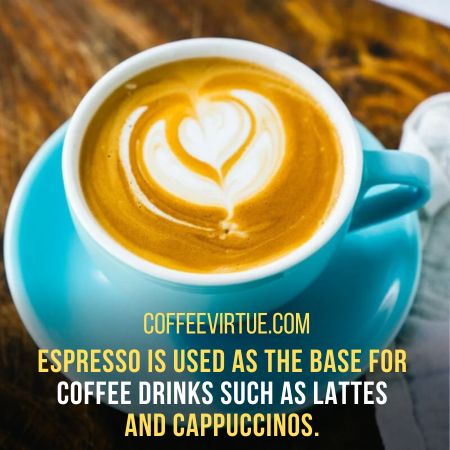Espresso and drip coffee are two of the most popular options. Both provide delicious beverages but differ in flavor, strength, and preparation.
What Will I learn
In this article, you’ll learn the difference between espresso and drip coffee. This article will help you to understand the basics of these two beverages.
Espresso Vs. Drip Coffee
If you’re looking for a strong, bold cup of coffee, then espresso is a great choice. Espresso is highly concentrated.
It’s made by passing hot water through finely-ground coffee beans at high pressure. It has a bold flavor, with more caffeine per ounce than drip coffee.
On the other hand, drip coffee is brewed by pouring boiling water over coffee grounds in a filter.
The grounds absorb the hot water and slowly drip into a pot or mug. This brewing method produces a lighter flavor than espresso and less caffeine per ounce.

The type of brew you choose depends on your preferences for taste and strength.
If you’re looking for a strong cup of coffee with an intense flavor, espresso is the way to go. If you prefer a more mellow flavor, drip coffee is your best bet.
Whichever brewing method you choose, both can provide a delicious cup of coffee.
Knowing the differences in flavor and caffeine content. It can help you find the perfect cup for any occasion.
So, get your grind on and enjoy a delicious cup of espresso or drip coffee.
4 Key Differences Between Espresso Vs. Drip Coffee
There are many different types of coffee, but two main varieties stand out: espresso and drip.
Both have distinct flavor profiles and brewing processes. So let’s look at the key differences between them.
1. Brewing Process:
The most obvious difference between espresso and drip coffee is how they are brewed.
Espresso machines force pressurized hot water through extremely fine, tightly packed coffee grounds.
In contrast, drip coffee has hot water passed through a filter containing coarser ground beans.
2. Flavor:
The flavor of espresso and drip differ due to their unique brewing processes. Espresso is known for its strong, intense flavor and creamy texture.
In contrast, drip coffee tends to be smoother with a more mellow taste.
3. Caffeine Content:
The amount of caffeine in both will also vary depending on the roast, grind, and brewing method.
Espresso contains more caffeine than drip coffee due to the smaller size of the servings.
However, this can also depend on how much coffee is used in each type of beverage.
4. Price:
Espresso tends to be more expensive than regular drip coffee. It is due to the specialized equipment required to make espresso, it
In contrast, a good home espresso machine may cost several hundred dollars. You also can get a decent drip coffeemaker for much less.
Espresso and drip coffee differ in brewing processes, flavor, caffeine content, and price.
Depending on your preferences and budget, one may suit you better. Ultimately, deciding which coffee is right for you is up to you.
Espresso Coffee
Espresso coffee has a much higher concentration of caffeine than regular drip-brewed coffee. It makes it very popular among those looking for an extra energy boost.
Espresso is often used as the base for coffee drinks such as lattes and cappuccinos.
In addition to its bold flavor and high caffeine content, espresso offers a range of health benefits.
It is due to its antioxidant properties and other compounds. It can help reduce inflammation, improve cognitive function, and boost metabolism.
5 Steps For Making the Perfect Cup of Espresso
Making espresso involves more than just grinding up some beans and adding hot water. To make the perfect cup of espresso.
Understanding how it is prepared and what factors influence its flavor is essential.
1. Selecting Your Beans:
The type of beans used for making espresso can significantly affect its taste.
Choosing high-quality Arabica or Robusta beans that have been freshly roasted.
2. Grinding The Beans:
A burr grinder, preferably conical-shaped. It is the best way to achieve a consistent grind size for espresso.
It should be fine enough to allow the water to flow through at an even rate but not so fine that it clogs up your machine.
3. Tamping The Grounds:
Once your beans are ground, it is important to tamp them into the portafilter evenly and firmly.
This ensures that all of the grounds get an equal amount of water during the extraction process.
4. Extracting The Espresso:
Place the portafilter in your espresso machine and pour hot water over it. The extraction time should take about 25-30 seconds.
It is during which you should see a dark brown stream of espresso begin to pour from the portafilter.
5. Serving:
Once the espresso is extracted, it will be served in your cup or mug.
To bring out its flavor, add sugar and milk if desired.
5 Positive Impacts Of Espresso Coffee
Espresso is an excellent choice for those looking to make a quick cup of coffee without sacrificing taste or health benefits.
Here are some of the positive impacts of espresso coffee:
1. Benefits Of Caffeine:
Caffeine is one of the main components of espresso and is known for its stimulating effects.
Caffeine can increase alertness, improve focus, and help with physical performance. Caffeine can also boost metabolism.
It allows your body to burn more calories throughout the day.
2. Improved Mood:
The combination of caffeine and other antioxidants. It founds that espresso may help to improve mood and reduce stress.
Research has shown that espresso can increase dopamine levels in the brain. It helps to create a feeling of pleasure and well-being.
3. Rich Flavor:
Espresso offers a unique flavor that is hard to find with other types of coffee.
The intense flavor comes from the darkly roasted beans used in espresso. It also gives a strong but pleasant taste.
4. Weight Loss:
Espresso can also help with weight loss thanks to its ability. It increases metabolism and reduces hunger cravings.
Studies have shown that espresso drinkers tend. It eats smaller portions throughout the day, aiding in weight loss efforts.
5. Antioxidants:
Espresso contains various antioxidants, which help protect the body from disease and aging.
These antioxidants are believed to have anti-inflammatory properties. It helps to reduce inflammation in the body.
Drip Coffee
Drip coffee is a type of brewed coffee that is popular worldwide. It is made by pouring hot water over ground coffee beans and allowing them to steep.

It steeps for several minutes before straining the liquid. The result is a strong, flavorful cup of coffee that can be enjoyed black or with milk and sugar added to taste.
Drip coffee is good for those looking for a strong cup of coffee without extra additives. It’s also quick and easy to make.
It makes it a popular choice for those who are short on time or don’t want to fuss with complicated equipment.
With the right methods, anyone can get a great cup of drip coffee in just minutes.
6 Steps For Making Delicious Drip Coffee
Drip Coffee is one of the most popular methods for making coffee. It’s simple and easy to make, plus it delivers a consistent taste every time you brew.
Here is a step-by-step guide on how to make drip coffee:
1. Gather Your Supplies:
You’ll need a few supplies to make your drip coffee. A coffee grinder, filter, coffee mug, and kettle are necessary.
You’ll also need the coffee beans of your choice.
2. Grind Your Beans:
The first step in making drip coffee is to grind your beans. Take the desired amount of beans and place them into the grinder.
Adjust the settings on the grinder to get the desired consistency. Once you have a consistent grind, remove the ground coffee and place it in your filter.
3. Place The Filter With Coffee Into Your Mug:
Once you’ve placed your grinds into the filter, place the filter with coffee into your mug.
Ensure that your mug can accommodate the amount of coffee you use.
4. Boil Water And Pour Into Your Mug:
The next step is to boil water in your kettle. Once it’s boiled, pour the hot water into your mug until it covers the filter with coffee grinds.
As you add the water, make sure not to disturb the grinds, as this can affect the flavor of your coffee.
5. Let The Coffee Steep:
Once you’ve added all the water to your mug, let it steep for several minutes.
This will give the coffee time to extract flavor from the grinds and create a flavorful cup of drip coffee.
6. Enjoy Your Cup Of Coffee:
Once the coffee has steeped, you can enjoy your drip coffee. Remove the coffee filter and discard it.
You can add cream, sugar, or any other topping you like to enhance the flavor of your beverage. Enjoy!
4 Positive Impacts Of Drip Coffee
Drip coffee is a popular brewing method that has been around for centuries. It’s known for its convenience, simplicity, and consistent taste.
There are several benefits to making drip coffee. It makes an ideal choice for home brewers and commercial establishments alike.
Let’s take a look at some of the positive impacts of drip coffee:
1. Quick And Easy Brewing:
Drip coffee is incredibly simple. You only need freshly ground beans, hot water, and a filter.
The entire process takes just minutes, making it an ideal choice for those on the go or with limited time.
2. Consistent Flavor:
Drip coffee produces a consistent flavor unlike other brewing methods, such as French press or pour-over.
The water is evenly distributed across all grounds. You can expect a reliable cup of joe that will taste the same every time you brew.
3. Cost Efficiency:
Drip coffee requires little equipment and is easy to clean up after use. It makes it one of the most cost-effective ways to brew coffee.

You don’t need fancy filters or expensive machines, just some ground beans and hot water!
4. Variety:
Drip coffee can be brewed with various ingredients. It ensures you never get bored with the same cup every time.
It’s flavored syrups for cafe-style drinks or spices for a special twist on your java. You can also find something to suit every taste.
As you can see, drip coffee offers a range of benefits that make it an ideal choice for coffee lovers everywhere.
Conclusion:
Regarding espresso versus drip coffee, several factors must be considered before deciding.
Both have unique flavors and differences in preparation and equipment. These can affect the final product’s taste.
Ultimately, the decision between espresso and drip coffee comes down to personal preference.
The intensity of espresso may be too strong for some people. Others may prefer the milder taste of drip coffee.
For those looking to mix up their daily routine or try something new, both types of coffee can be great options.
No matter your preference, there is a coffee out there to suit everyone’s taste.